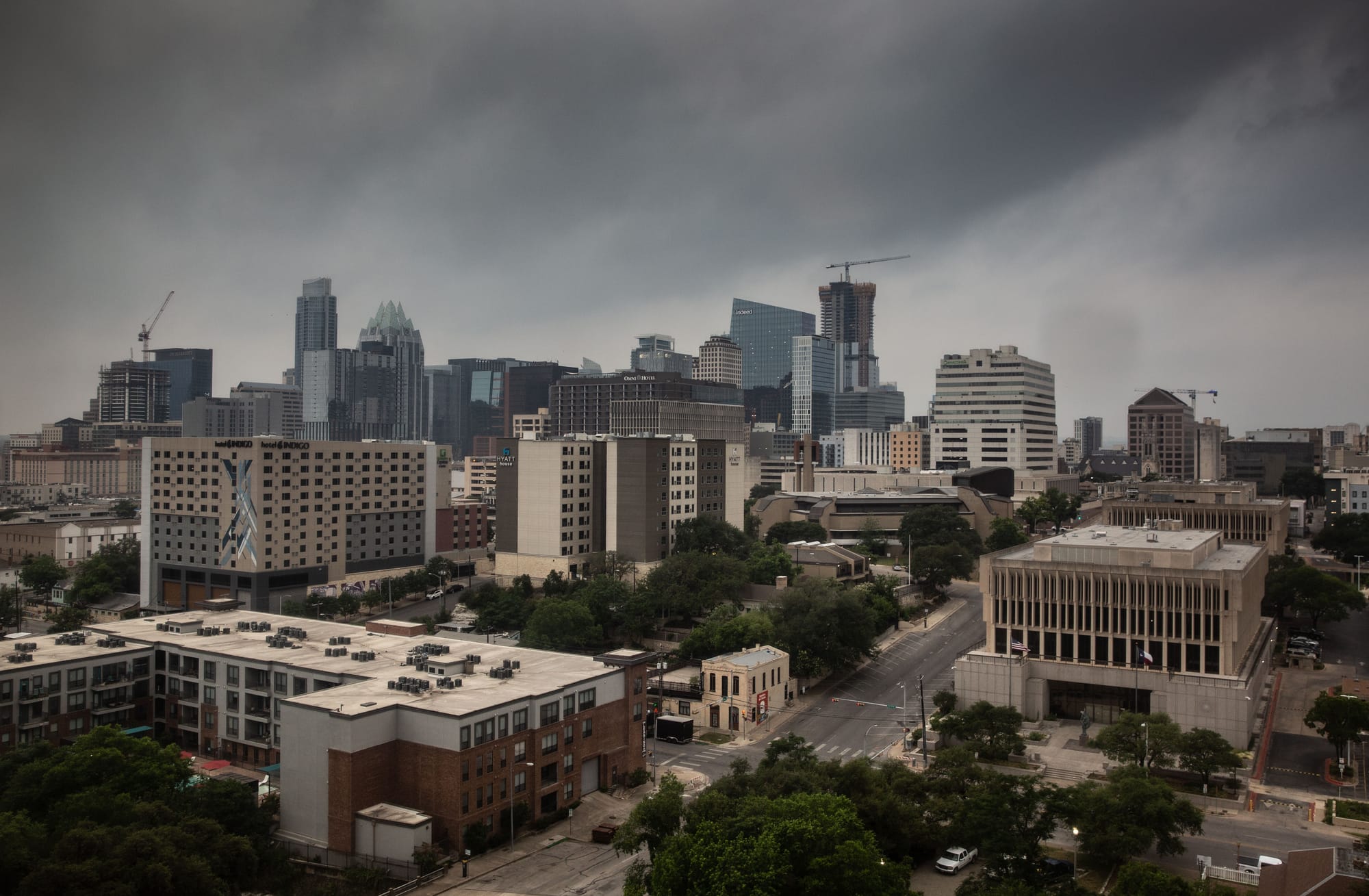☀️ Happy Monday, Austin.
We might joke about how rainfall skirts our city. Today, let's hash it out: Is the so-called Austin rain dome a thing?
Then, find out how to reseed bluebonnets for next year — yes, you can do that! — and peep a tweet that shows another thing Austin's garnered a reputation for.
Our city's invisible rain shield
We’ve all witnessed it: Thunderstorms moving east out of the Hill Country often weaken, fall apart or split once they reach the city limits of Austin.
And we all know the name that folks have dubbed this invisible shield: the Austin rain dome.
In lots of towns, people think that “they live in a ‘bubble’ because they do occasionally witness rain or storms approaching that seem to dissipate as they arrive,” said longtime Austin meteorologist Jim Spencer. “Anecdotally, they are correct, but over time their hypotheses don't ‘hold water,’ because they forget the many times that they get soaking rain and storms.”
So yeah, Austin’s rain dome may seem to be simply an urban legend. But there's some scientific truth to it, based on the direction of the weather and the dynamics at play.

Central Texas geography plays a huge part in how storms do or don't develop. Austin is bracketed by the higher elevations of the Hill Country to the west and the flatter landscape of the Coastal Plains to the east. Austin sits along the Balcones Escarpment, a steep slope that divides the different elevations.
Strong storms use surface winds to lift the warm air they need to continue churning in the atmosphere. Once that inflow gets disrupted, the storms weaken. Sometimes this happens when storms approach from the west and, at the edge of the escarpment, the bottom drops out of the storm system. Then it will intensify once it reaches the east side of the city when the surface inflow can be re-established.
But that’s not always the case: The escarpment can also serve as a focal point for extremely heavy rainfall, giving this region a basis for the nickname “Flash Flood Alley.” Abundant moisture-rich air from both the Gulf of Mexico and the Pacific Ocean can contribute to this heavy rainfall. Often, this happens when the edge of a cold front stalls and parks itself over Central Texas.
“The Balcones Escarpment is at higher elevations, thus funneling low-level moisture north up through the I-35 corridor,” Spencer said. “That deeper moisture results in higher annual average rainfall from the Austin area, eastward, and lower amounts to the west of Williamson, Travis and Hays counties.”
Several other factors influence a storm around the city:
🌬️ Tall buildings can funnel wind and alter wind speed and direction.
🛣️ Because of the urban heat island effect, roads, parking lots and concrete make the city warmer.
🌡️ Pollution and ground-level ozone can influence the temperatures.
🌳 The number of green spaces helps cool various parts of the city.
In short, when atmospheric temperatures, moisture and pressure levels change as a storm approaches, it can disrupt the strength of the storm.
Why does the legend of the rain dome persist, even when certain rain events have disproved it?
“It's just that those times when the storm seems to ‘split’ or go around your area are more memorable,” Spencer said.
— Mary Wasson, Meteorologist

Temperature: 84 degrees | Sun: Behind clouds | What to Expect: Scattered thunderstorms
This past weekend’s unsettled weather will carry into the new week with a rain chance every day. Today will be muggy, warm and a bit stormy with pockets of heavy rain at times. High temperatures will climb into the low to mid-80s.
Mary’s Tip: Head down to Waterloo Records at 4:30 p.m. for an in-store performance and record signing by Charley Crockett.
Time to reseed some bluebonnets, y'all
If you missed the chance to see the Texas bluebonnets (or Lupinus texensis) this year, don't worry. Now is the perfect time to start your own Texas-size bluebonnet patch. Here's how:
Once the blue flowers fall off, you'll notice fuzzy, edamame-looking, seed pods forming on the plants. These pods will mature and dry out, turning yellow and then brown. While Mother Nature will eventually take over and the seed pods will explode to disperse their seeds for next year's crop, you can take control by harvesting the seeds on your own. This is a fantastic way to ensure that your bluebonnet patch doesn't spread too far and to sow another area of your home.
“The best method in collecting the most seed is to harvest the entire bluebonnet plant,” said Amy Medley, lead horticulturist at the Lady Bird Johnson Wildflower Center. “Then place the entire plant in a paper bag upside down, so the seed pods point downward to the bottom and the roots of the plant are up.”

Store the plant in a cool, dry place, she said. Once the seeds mature, the seed pods explode inside the bag, depositing the seeds into the bottom of it.
The bluebonnet seeds will need to be stored safely for a couple of months before planting in October. Before you sow them, you can help the seeds reach a better rate of germination by breaking down the seed’s hard coating.
“Here in the gardens, we freeze our bluebonnet seeds for at least 24 hours and then soak them in very warm water for about 5 minutes,” Medley said.
Once you plant the seeds, you must ensure they get adequate moisture, or they will dry up and die. If the weather cooperates and we receive average rainfall in the fall and winter, then no supplemental water is needed during this growing period. The seeds need to be kept moist, not oversaturated but allowing for the soil to dry out between rainy events.
Bluebonnets prefer to be by themselves and not crowded by other plants. They love bad soil, so anywhere with decomposed granite or rocky soil is the perfect place for them to thrive.
And lucky for us, they love the strong Texas sun, so anywhere with full sunshine will do fine.
— Mary Wasson, Meteorologist
Tweet of the Day
If you live here, we don't need to tell you that pickleball has made itself nice and comfy in our city. There are new, 16-court complexes devoted to the sport popping up around Austin seemingly all the time. It's hard not to associate our home with pickleball at this point.
As is evident by a tweet posted a few days ago:

The tweet could also mean something else: that pickleball style, and athleisure attire in general, is also now an Austin Thing.
Call us crazy, but when it's 100 degrees 30 days in a row, you'd want to only be wearing workout clothes, too. So don't @ us.
🧑🎤 Get Me Bodied
Today's clue is for 1 Down: What Uchi has partly become known for since it opened on South Lamar in 2003.

What'd you think of today's issue?
- 👍 10 points to Gryffindor. Y'all killed it.
- 😐 Meh. Wasn't bad, wasn't great.
- 👎 Yeah it's gonna be a no from me, dawg.

We’re so glad you found us. Find our bios and contact info here, or reach out at hello@austindaily.com. Behind today’s send: Katie Canales and Mary Wasson.


